Due to a bug in Windows Azure, all self-signed client certificates used with the Azure REST API from a Windows 8 application must be specified as extended validation certificates.
To provide a better user experience, I am trying to generate this self-signed certificate on a remote server. I'm using the Certificate Enrolment API, a COM library distributed as part of Windows, as described in this answer to the question How to create a self-signed certificate using C#?
The code is largely the same, just slightly modified for my own use:
public static X509Certificate2 CreateSelfSignedCertificate(
string cname,
string friendlyName,
string password)
{
// create DN for subject and issuer
var dn = new CX500DistinguishedName();
dn.Encode("CN=" + cname, X500NameFlags.XCN_CERT_NAME_STR_NONE);
// create a new private key for the certificate
CX509PrivateKey privateKey = new CX509PrivateKey();
privateKey.ProviderName = "Microsoft Base Cryptographic Provider v1.0";
privateKey.MachineContext = true;
privateKey.Length = 2048;
privateKey.KeySpec = X509KeySpec.XCN_AT_SIGNATURE; // use is not limited
privateKey.ExportPolicy
= X509PrivateKeyExportFlags.XCN_NCRYPT_ALLOW_PLAINTEXT_EXPORT_FLAG;
privateKey.Create();
// Use the stronger SHA512 hashing algorithm
var hashobj = new CObjectId();
hashobj.InitializeFromAlgorithmName(
ObjectIdGroupId.XCN_CRYPT_HASH_ALG_OID_GROUP_ID,
ObjectIdPublicKeyFlags.XCN_CRYPT_OID_INFO_PUBKEY_ANY,
AlgorithmFlags.AlgorithmFlagsNone,
"SHA512");
// Create the self signing request
var cert = new CX509CertificateRequestCertificate();
cert.InitializeFromPrivateKey(
X509CertificateEnrollmentContext.ContextMachine,
privateKey,
string.Empty);
cert.Subject = dn;
cert.Issuer = dn; // the issuer and the subject are the same
cert.NotBefore = DateTime.Now;
cert.NotAfter = DateTime.Now.AddYears(50);
cert.HashAlgorithm = hashobj;
var clientAuthenticationOid = new CObjectId();
clientAuthenticationOid.InitializeFromValue("1.3.6.1.5.5.7.3.2");
// Set up cert to be used for Client Authentication.
var oids = new CObjectIds();
oids.Add(clientAuthenticationOid);
var eku = new CX509ExtensionEnhancedKeyUsage();
eku.InitializeEncode(oids);
cert.X509Extensions.Add((CX509Extension)eku);
// Add the certificate policy.
var policy = new CCertificatePolicy();
policy.Initialize(clientAuthenticationOid);
// THIS IS WRONG - NEEDS A DIFFERENT QUALIFIER
var qualifier = new CPolicyQualifier();
qualifier.InitializeEncode(
"c0",
PolicyQualifierType.PolicyQualifierTypeUserNotice);
policy.PolicyQualifiers.Add(qualifier);
var policies = new CCertificatePolicies();
policies.Add(policy);
var ecp = new CX509ExtensionCertificatePolicies();
ecp.InitializeEncode(policies);
cert.X509Extensions.Add((CX509Extension)ecp);
cert.Encode();
// Do the final enrolment process
var enroll = new CX509Enrollment();
enroll.InitializeFromRequest(cert); // load the certificate
enroll.CertificateFriendlyName = friendlyName;
string csr = enroll.CreateRequest(); // Output the request in base64
// and install it back as the response
enroll.InstallResponse(
InstallResponseRestrictionFlags.AllowUntrustedCertificate,
csr,
EncodingType.XCN_CRYPT_STRING_BASE64,
""); // no password
// output a base64 encoded PKCS#12 for import to .NET
var base64encoded = enroll.CreatePFX(
password,
PFXExportOptions.PFXExportChainWithRoot);
// instantiate the target class with the PKCS#12 data
return new X509Certificate2(
System.Convert.FromBase64String(base64encoded),
password,
X509KeyStorageFlags.Exportable);
}
I've found the ICertificatePolicy interface which appears to represent the right type of structure, but I can't deduce the right IPolicyQualifier to use. In my code, the qualifier is
For clarity, this where you configure the information in the Windows 8 Certificate Manager:

Which produces this property on the certificate:

My code currently produces this property:

Close, but not there yet.
Is there another way to load data into the IPolicyQualifier so that it produces the expected result, perhaps using the InitialiseDecode method?
